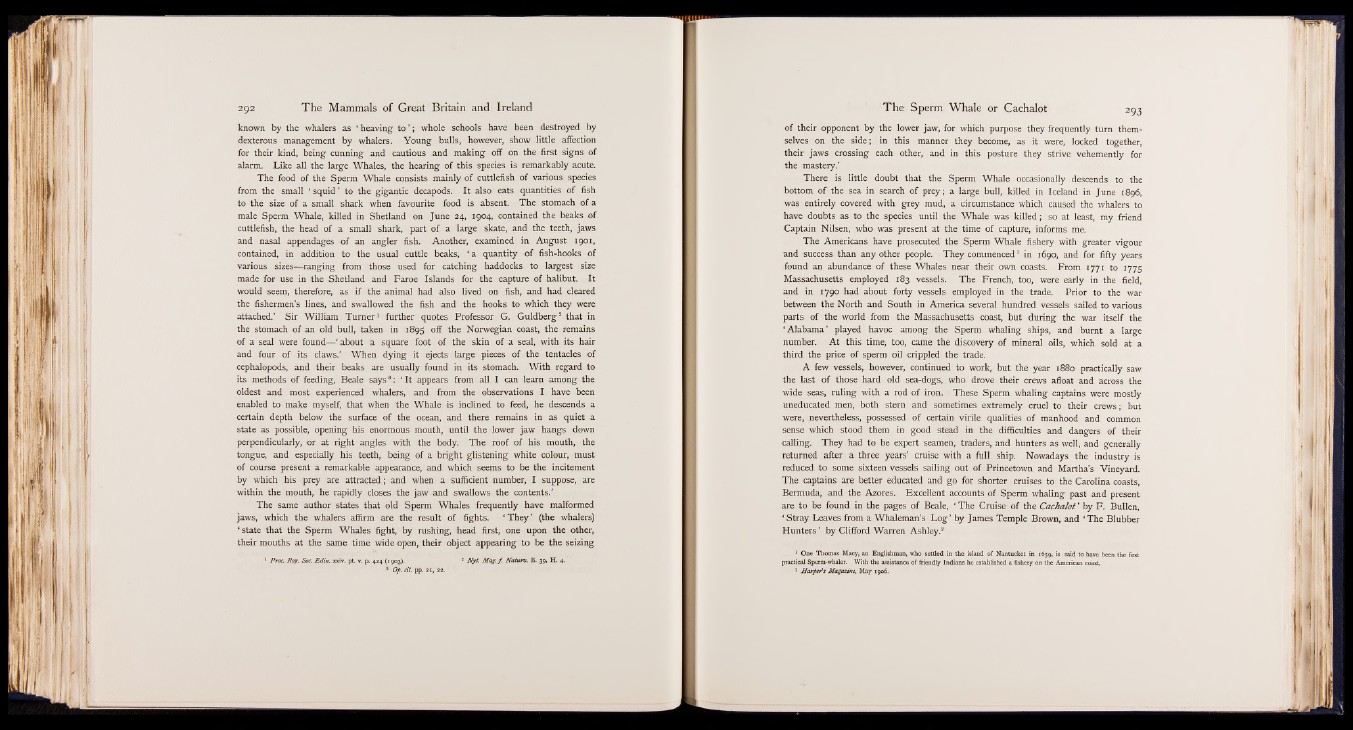
known by the whalers as ‘ heaving to ’ ; whole schools have been destroyed by
dexterous management by whalers. Young bulls, however, show little affection
for their kind, being cunning and cautious and making off on the first signs of
alarm. Like all the large Whales, the hearing of this species is remarkably acute.
The food of the Sperm Whale consists mainly of cuttlefish of various species
from the small ‘ squid ’ to the gigantic decapods. It also eats quantities of fish
to the size of a small shark when favourite food is absent. The stomach of a
male Sperm Whale, killed in Shetland on June 24, 1904, contained the beaks of
cuttlefish, the head of a small shark, part of a large skate, and the teeth, jaws
and nasal appendages of an angler fish. Another, examined in August 1901,
contained, in addition to the usual cuttle beaks, ‘ a quantity of fish-hooks of
various sizes— ranging from those used for catching haddocks to largest size
made for use in the Shetland and Faroe Islands for the capture of halibut. It
would seem, therefore, as if the animal had also lived on fish, and had cleared
the fishermen’s lines, and swallowed the fish and the hooks to which they were
attached.’ Sir William Turner1 further quotes Professor G. Guldberg2 that in
the stomach of an old bull, taken in 1895 off the Norwegian coast, the remains
of a seal were found— ‘ about a square foot of the skin of a seal, with its hair
and four of its claws.’ When dying it ejects large pieces of the tentacles of
cephalopods, and their beaks are usually found in its stomach. With regard to
its methods of feeding, Beale says8: 4 It appears from all I can learn among the
oldest and most experienced whalers, and from the observations I have been
enabled to make myself, that when the Whale is inclined to feed, he descends a
certain depth below the surface of the ocean, and there remains in as quiet -a
state as possible, opening his enormous mouth, until the lower jaw hangs down
perpendicularly, or at right angles with the body. The roof of his mouth, the
tongue, and especially his teeth, being of a bright glistening white colour, must
of course present a remarkable appearance, and which seems to be the incitement
by which his prey are attracted; and when a sufficient number, I suppose, are
within the mouth, he rapidly closes the jaw and -swallows the contents.’
The same author states that old Sperm Whales frequently have malformed
jaws, which the whalers affirm are the result of fights. ‘ They’ (the whalers)
‘ state that the Sperm Whales fight, by rushing, head first, one upon the other,
their mouths at the same time wide open, their object appearing to be the seizing
1 Proc. Roy. Soc. Edin. xxiv. pt. v. p. 424 (1903).
3 Op. cit. pp. 21, 22.
3 Nyt. M ag.f. Naturv. B. 39, H. 4.
of their opponent by the lower jaw, for which purpose they frequently turn themselves
on the side; in this manner they become, as it were, locked together,
their jaws crossing each other, and in this posture they strive vehemently for
the mastery.’
There is little doubt that the Sperm Whale occasionally descends to the
bottom of the sea in search of prey; a large bull, killed in Iceland in June 1896,
was entirely covered with grey mud, a circumstance which caused the whalers to
have doubts as to the species until the Whale was killed; so at least, my friend
Captain Nilsen, who was present at the time of capture, informs me.
The Americans have prosecuted the Sperm Whale fishery with greater vigour
and success than any other people. They commenced1 in 1690, and for fifty years
found an abundance of these Whales near their own coasts. From 1771 to 1775
Massachusetts employed 183 vessels. The French, too, were early in the field,
and in 1790 had about forty vessels employed in the trade. Prior to the war
between the North and South in America several hundred vessels sailed to various
parts of the world from the Massachusetts coast, but during the war itself the
‘ Alabama’ played havoc among the Sperm whaling ships, and burnt a large
number. At this time, too, came the discovery of mineral oils, which sold at a
third the price of sperm oil crippled the trade.
A few vessels, however, continued to work, but the year 1880 practically saw
the last of those hard old sea-dogs, who drove their crews afloat and across the
wide seas, ruling with a rod of iron. These Sperm whaling captains were mostly
uneducated men, both stern and sometimes extremely cruel to their crews; but
were, nevertheless, possessed of certain virile qualities of manhood and common
sense which stood them in good stead in the difficulties and dangers of their
calling. They had to be expert seamen, traders, and hunters as well, and generally
returned after a three years’ cruise with a full ship. Nowadays the industry is
reduced to some sixteen vessels sailing out of Princetown and Martha’s Vineyard.
The captains are better educated and go for shorter cruises to the Carolina coasts,
Bermuda, and the Azores. Excellent accounts of Sperm whaling past and present
are to be found in the pages of Beale, ‘ The Cruise of the Cachalot ’ by F. Bullen,
‘ Stray Leaves from a Whaleman’s L o g ’ by James Temple Brown, and ‘ The Blubber
Hunters ’ by Clifford Warren Ashley.2
1 One Thomas Macy, an Englishman, who settled in the island of Nantucket in 1659, is said to have been the first
practical Sperm-whaler. With the assistance of friendly Indians he established a fishery on the American coast.
8 Harper’ s Magazine, May 1906.